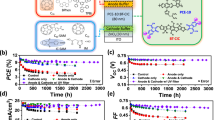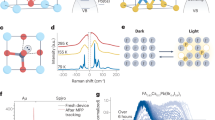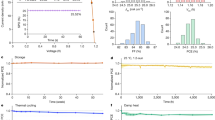Abstract
Organic photovoltaic cells are now approaching commercially viable efficiencies, particularly for applications that make use of their unique potential for flexibility and semitransparency1,2,3. However, their reliability remains a major concern, as even the most stable devices reported so far degrade within only a few years4,5,6,7,8. This has led to the belief that short operational lifetimes are an intrinsic disadvantage of devices that are fabricated using weakly bonded organic materials—an idea that persists despite the rapid growth and acceptance of organic light-emitting devices, which can achieve lifetimes of several million hours9. Here we study an extremely stable class of thermally evaporated single-junction organic photovoltaic cells. We accelerated the ageing process by exposing the packaged cells to white-light illumination intensities of up to 37 Suns. The cells maintained more than 87 per cent of their starting efficiency after exposure for more than 68 days. The degradation rate increases superlinearly with intensity, leading to an extrapolated intrinsic lifetime, T80, of more than 4.9 × 107 hours, where T80 is the time taken for the power conversion efficiency to decrease to 80 per cent of its initial value. This is equivalent to 27,000 years outdoors. Additionally, we subjected a second group of organic photovoltaic cells to 20 Suns of ultraviolet illumination (centred at 365 nanometres) for 848 hours, a dose that would take 1.7 × 104 hours (9.3 years) to accumulate outdoors. No efficiency loss was observed over the duration of the test. Overall, we find that organic solar cells packaged in an inert atmosphere can be extremely stable, which is promising for their future use as a practical energy-generation technology.
This is a preview of subscription content, access via your institution
Access options
Access Nature and 54 other Nature Portfolio journals
Get Nature+, our best-value online-access subscription
$29.99 / 30 days
cancel any time
Subscribe to this journal
Receive 51 print issues and online access
$199.00 per year
only $3.90 per issue
Buy this article
- Purchase on Springer Link
- Instant access to full article PDF
Prices may be subject to local taxes which are calculated during checkout




Similar content being viewed by others
Data availability
The data that support the findings of this study are available from the corresponding author upon reasonable request.
References
Che, X., Li, Y., Qu, Y. & Forrest, S. R. High fabrication yield organic tandem photovoltaics combining vacuum- and solution-processed subcells with 15% efficiency. Nat. Energy 3, 422–427 (2018).
Li, Y. et al. High efficiency near-infrared and semitransparent non-fullerene acceptor organic photovoltaic cells. J. Am. Chem. Soc. 139, 17114–17119 (2017).
Chang, S., Cheng, P., Li, G. & Yang, Y. Transparent polymer photovoltaics for solar energy harvesting and beyond. Joule 2, 1039–1054 (2018).
Peters, C. H. et al. High efficiency polymer solar cells with long operating lifetimes. Adv. Energy Mater. 1, 491–494 (2011).
Baran, D. et al. Reducing the efficiency-stability-cost gap of organic photovoltaics with highly efficient and stable small molecule acceptor ternary solar cells. Nat. Mater. 16, 363–369 (2017).
Gasparini, N. et al. Burn-in free nonfullerene-based organic solar cells. Adv. Energy Mater. 7, 1700770 (2017).
Burlingame, Q. et al. Reliability of small molecule organic photovoltaics with electron-filtering compound buffer layers. Adv. Energy Mater. 6, 1601094 (2016).
Sapkota, S. B., Spies, A., Zimmermann, B., Dürr, I. & Würfel, U. Promising long-term stability of encapsulated ITO-free bulk-heterojunction organic solar cells under different aging conditions. Sol. Energy Mater. Sol. Cells 130, 144–150 (2014).
Burrows, P. E. & Forrest, S. R. Operating lifetime of phosphorescent organic light emitting devices. Appl. Phys. Lett. 76, 2493 (2000).
Zhang, H. et al. Photochemical transformations in fullerene and molybdenum oxide affect the stability of bilayer organic solar cells. Adv. Energy Mater. 5, 1–9 (2014).
Liu, X., Ding, K., Panda, A. & Forrest, S. R. Charge transfer states in dilute donor–acceptor blend organic heterojunctions. ACS Nano 10, 7619–7626 (2016).
Haillant, O., Dumbleton, D. & Zielnik, A. An Arrhenius approach to estimating organic photovoltaic module weathering acceleration factors. Sol. Energy Mater. Sol. Cells 95, 1889–1895 (2011).
F́ry, C., Racine, B., Vaufrey, D., Doyeux, H. & Ciǹ, S. Physical mechanism responsible for the stretched exponential decay behavior of aging organic light-emitting diodes. Appl. Phys. Lett. 87, 1–3 (2005).
Hermenau, M. et al. The effect of barrier performance on the lifetime of small-molecule organic solar cells. Sol. Energy Mater. Sol. Cells 97, 102–108 (2012).
Scholz, S., Kondakov, D., Lüssem, B. & Leo, K. Degradation mechanisms and reactions in organic light-emitting devices. Chem. Rev. 115, 8449–8503 (2015).
Zhang, Y., Lee, J. & Forrest, S. R. Tenfold increase in the lifetime of blue phosphorescent organic light-emitting diodes. Nat. Commun. 5, 5008 (2014).
Habte, A., Sengupta, M. & Lopez, A. Evaluation of the National Solar Radiation Database (NSRDB): 1998–2015. Report No. NREL/TP-5D00-67722 (National Renewable Energy Laboratory, 2017).
Garner, L. E. et al. Photobleaching dynamics in small molecule vs. polymer organic photovoltaic blends with 1,7-bis-trifluoromethylfullerene. J. Mater. Chem. A 6, 4623–4628 (2018).
Lakhwani, G., Rao, A. & Friend, R. H. Bimolecular recombination in organic photovoltaics. Annu. Rev. Phys. Chem. 65, 557–581 (2014).
Bartesaghi, D. et al. Competition between recombination and extraction of free charges determines the fill factor of organic solar cells. Nat. Commun. 6, 7083 (2015).
Dibb, G. F. A., Jamieson, F. C., Maurano, A., Nelson, J. & Durrant, J. R. Limits on the fill factor in organic photovoltaics: distinguishing nongeminate and geminate recombination mechanisms. J. Phys. Chem. Lett. 4, 803–808 (2013).
Vandewal, K., Tvingstedt, K., Gadisa, A., Inganäs, O. & Manca, J. V. On the origin of the open-circuit voltage of polymer–fullerene solar cells. Nat. Mater. 8, 904–909 (2009).
Rau, U. Reciprocity relation between photovoltaic quantum efficiency and electroluminescent emission of solar cells. Phys. Rev. B 76, 085303 (2007).
Franke, R., Maennig, B., Petrich, A. & Pfeiffer, M. Long-term stability of tandem solar cells containing small organic molecules. Sol. Energy Mater. Sol. Cells 92, 732–735 (2008).
Pearson, A. J. et al. Critical light instability in CB/DIO processed PBDTTT-EFT:PC71BM organic photovoltaic devices. Org. Electron. 30, 225–236 (2016).
Jeong, C. et al. Understanding molecular fragmentation in blue phosphorescent organic light-emitting devices. Org. Electron. 64, 15–21 (2019).
Giebink, N. C. et al. Intrinsic luminance loss in phosphorescent small-molecule organic light emitting devices due to bimolecular annihilation reactions. J. Appl. Phys. 103, 044509 (2008).
Lee, J. et al. Hot excited state management for long-lived blue phosphorescent organic light-emitting diodes. Nat. Commun. 8, 1–9 (2017).
Burlingame, Q. et al. Photochemical origins of burn-in degradation in small molecular weight organic photovoltaic cells. Energy Environ. Sci. 8, 1005–1010 (2015).
Wilson, P. F. & Ma, M. T. Fields radiated by electrostatic discharges. IEEE Trans. Electromagn. Compat. 33, 10–18 (1991).
Wang, N. et al. Snow cleaning of substrates increases yield of large-area organic photovoltaics. Appl. Phys. Lett. 101, 133901 (2012).
Burlingame, Q., Zanotti, G., Ciammaruchi, L., Katz, E. A. & Forrest, S. R. Outdoor operation of small-molecule organic photovoltaics. Org. Electron. 41, 274–279 (2017).
Acknowledgements
This work was supported by the United States Department of Energy SunShot Program under awards DE-EE0006708 and DE-EE0005310 and the Department of the Navy, Office of Naval Research under award N00014-17-1-2211.
Author information
Authors and Affiliations
Contributions
Q.B. constructed the high-intensity LED ageing setup and designed experimental protocols. Q.B. and X.H. fabricated all samples, performed all measurements, and analysed and fitted the data. X.L. assisted with electroluminescence measurements and performed the transient photoluminescence spectroscopy. C.J. collected the mass spectra on organic films. C.C. and X.H. constructed the ultraviolet ageing system and C.C. performed the error analysis of the acceleration factor. S.R.F. supervised the project and analysed the data. The manuscript was written by Q.B., X.H. and S.R.F., and edited by all co-authors.
Corresponding author
Ethics declarations
Competing interests
The authors declare no competing interests.
Additional information
Publisher’s note: Springer Nature remains neutral with regard to jurisdictional claims in published maps and institutional affiliations.
Extended data figures and tables
Extended Data Fig. 1 Spectrum of an Xe-arc solar simulator lamp over time.
Spectrum (left axis) of the Xe-arc lamp used for 1-Sun ageing of the OPVs, both before (black) and after (red) operating continuously for 2,000 h. EQEs (right axis) of the Si reference cell (blue) used for calibrating the intensity of the Xe-arc lamp intensity, and the EQE of a DBP:C70 OPV cell (pink). Previously, we reported the operational stability of DBP:C70 OPV cells with an identical structure to those studied here, and found that JSC degraded linearly with time when measured in situ under continuous illumination from a Xe-arc lamp7. The spectrum of the Xe-arc lamp red-shifts with time as shown, leading to an underestimation of the lifetime of the OPV cells. In this study, the EQE and current–voltage characteristics were measured between solar-ageing periods to avoid this error.
Extended Data Fig. 2 Charge-extraction efficiency and wavelength-dependent EQE spectra.
a, Charge-extraction efficiency at V = 0 (extracted from the reverse-bias photocurrent data, as described in Methods) plotted against time. b, Wavelength-dependent EQE spectra after 47 days of ageing at 9.5, 20 and 37 Suns. The inset shows the change in EQE after 47 days; that is, ΔEQE = [EQE(t = 47 days) − EQEfresh]/EQEfresh.
Extended Data Fig. 3 High-intensity LED ageing system and performance characterization.
a, b, Side (a) and top (b) views of the water-cooled white-LED setup used to supply high-intensity illumination to the OPVs. Each of the four stations consists of a cool-white LED (colour temperature = 5,000 K) with a heat sink and active water cooling of an Al block attached to the substrate. Cylindrical Ag-coated light pipes are used to collimate the LED light onto the OPV, shown detail in c. Despite the reflectivity of the Ag coating being greater than 99%, the OPV and its reflections are visible through the pipe owing to the extreme light intensity within. d, The spectrum of the white LEDs, ultraviolet LED and Xe-arc lamp measured at the surface of the OPV, compared with the AM1.5G spectrum. e, Surface temperature of the OPV cells plotted against intensity, across the range of white LED output intensities. The three ageing conditions used for OPV cells and thin films are indicated on the plot.
Extended Data Fig. 4 Current–voltage characteristics of aged OPVs.
Dark current (Jdark, left axis) and current under 1-Sun illumination (J1-Sun, right axis) as a function of applied voltage for an OPV before and after ageing for 47 days under illumination at 37 Suns.
Extended Data Fig. 5 Correlation between degradation of VOC and decrease in electroluminescence intensity.
To quantify the effect of recombination on the performance of the device, we express the change in VOC as: \(\Delta {V}_{{\rm{OC}}}={V}_{{\rm{OC}}}\left(0\right)-{V}_{{\rm{OC}}}\left(t\right)=\frac{{k}_{{\rm{B}}}T}{q}{\rm{ln}}\left(\frac{{J}_{{\rm{SC}}}\left(0\right)}{{J}_{{\rm{SC}}}\left(t\right)}\frac{{{\rm{EQE}}}_{{\rm{EL}}}\left(t\right)}{{{\rm{EQE}}}_{{\rm{EL}}}\left(0\right)}\frac{\int {{\rm{EQE}}}_{{\rm{PV}}}\left(t\right){\Phi }_{{\rm{BB}}}{\rm{d}}E}{\int {{\rm{EQE}}}_{{\rm{PV}}}\left(0\right){\Phi }_{{\rm{BB}}}{\rm{d}}E}\right)\) where kB is Boltzmann’s constant, T is the cell temperature, q is the charge of an electron, EQEEL is the electroluminescence quantum efficiency of the charge-transfer states, EQEPV is the photovoltaic quantum efficiency, ΦBB is the black-body flux incident on the device, and E is the photon energy22. Predicted values of ΔVOC calculated using the above equation are plotted as a function of time along with the measured change in VOC. For the above equation to accurately predict the change in VOC, each of the parameters should be measured under an illumination intensity of 1 Sun. Because EQEEL was measured in the dark at a constant current density of 4 mA cm−2 rather than at JSC (that is, under 1-Sun illumination), the absolute value of the prediction from the above equation differs from the measured ΔVOC by approximately a factor of 2. Nevertheless, there is a qualitative match between the degradation time constants of the predicted and measured ΔVOC, which suggests that EQEEL measurements are a useful test of recombination and voltage loss in photovoltaic-degradation studies.
Rights and permissions
About this article
Cite this article
Burlingame, Q., Huang, X., Liu, X. et al. Intrinsically stable organic solar cells under high-intensity illumination. Nature 573, 394–397 (2019). https://doi.org/10.1038/s41586-019-1544-1
Received:
Accepted:
Published:
Issue Date:
DOI: https://doi.org/10.1038/s41586-019-1544-1
This article is cited by
-
Polymer-acid-metal quasi-ohmic contact for stable perovskite solar cells beyond a 20,000-hour extrapolated lifetime
Nature Communications (2024)
-
Tuning polymer-backbone coplanarity and conformational order to achieve high-performance printed all-polymer solar cells
Nature Communications (2024)
-
Achieving sustainability of greenhouses by integrating stable semi-transparent organic photovoltaics
Nature Sustainability (2023)
-
Accelerated ageing of organic and perovskite photovoltaics
Nature Energy (2023)
-
Long-term solar water and CO2 splitting with photoelectrochemical BiOI–BiVO4 tandems
Nature Materials (2022)
Comments
By submitting a comment you agree to abide by our Terms and Community Guidelines. If you find something abusive or that does not comply with our terms or guidelines please flag it as inappropriate.



